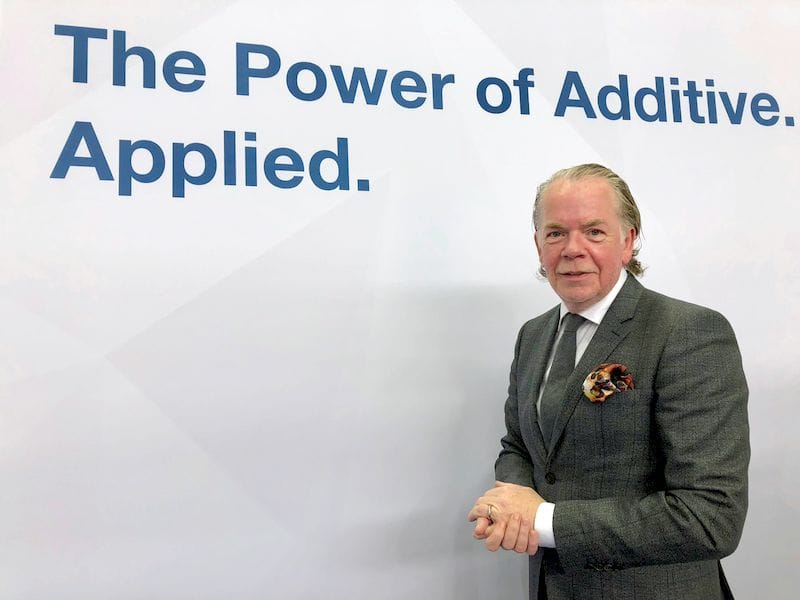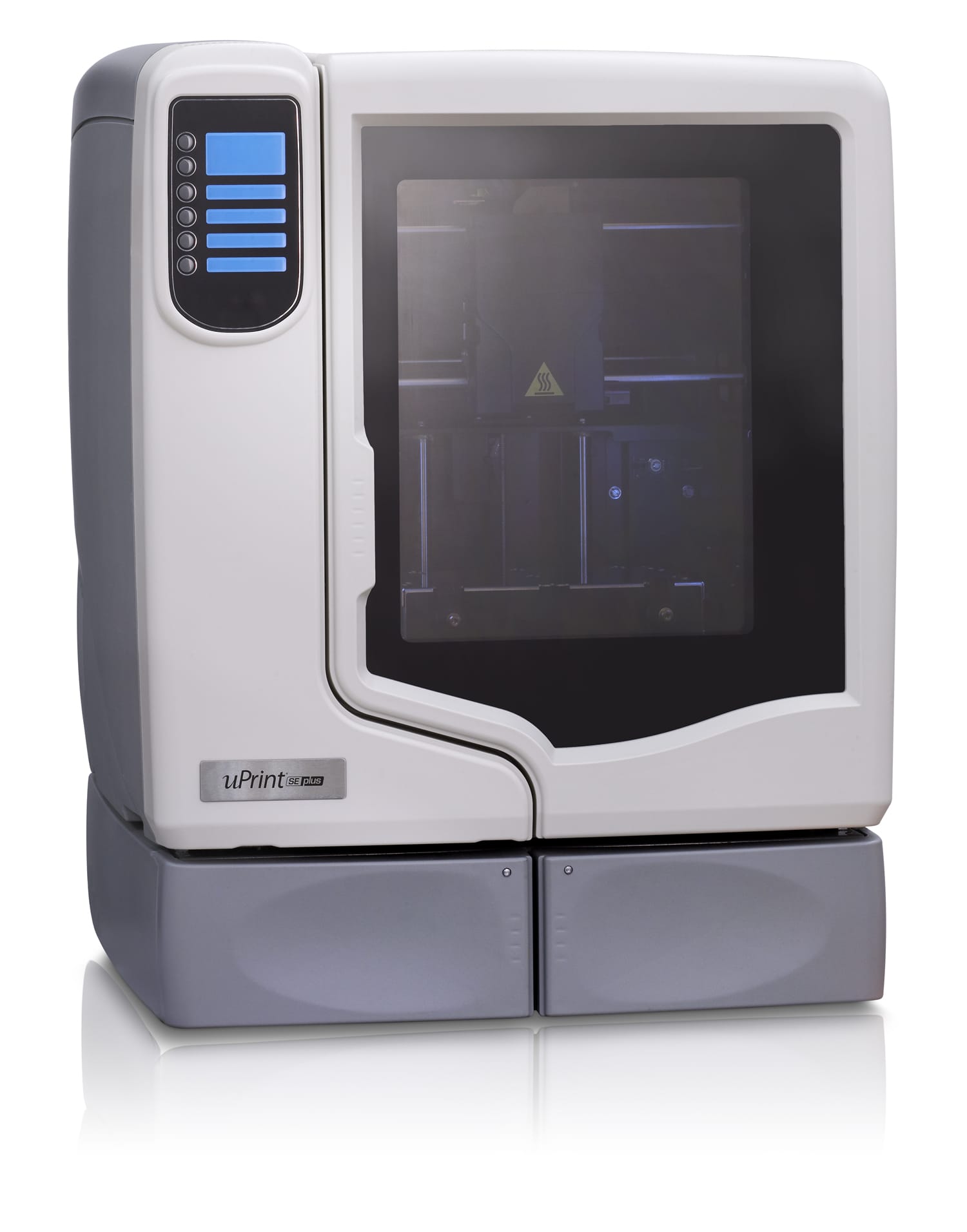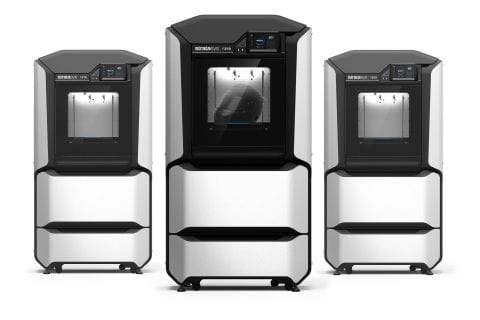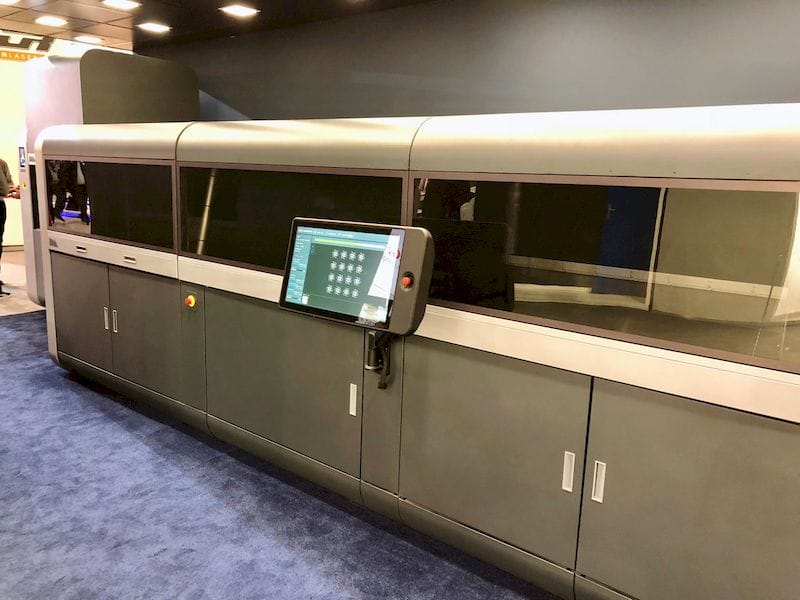
We spent quite a bit of time talking to Stratasys’ European President, Andy Middleton about the company’s plans for the future.
Stratasys is at an interesting point in its history, as it faces an increasing amount of competition from smaller vendors, while at the same time moving their product line towards more production functions.
This is part 2 of a 2 part series. Part 1 is here.
Fabbaloo: Let’s talk about competition. There’s tons of machines that are biting away at your ankles and some of them are offering different capabilities, like higher temperature materials, larger volumes, etc. Is that a problem for Stratasys? Or does it even matter, with the F-series capabilities?
Andy Middleton: It’s a great question. I was hoping you wouldn’t ask it! No, I’m only joking. If we don’t see it as a problem then we’re not doing a good job.
We are currently in the favorable position of having a leading position with the industry. However, you don’t even need 30 minutes walking around here to see what else is coming out. We shouldn’t be in any way dismissive of their capabilities. We need to take it seriously.
The Stratasys view is there are two big areas of growth going forward. One is in the sub-ten thousand dollar professional printer. I’m avoiding the word “desktop”. Whether it be FDM base or resin base, it’s a big opportunity. It’s going to have exponential growth, we’ve seen it. Then from a technology perspective we’re going to see double, triple-digit growth in metal within the industry. I am convinced, we are convinced.
Now, which technology is going to be dominant? Separate question. So to answer your question, yes we take it extremely seriously. Worried is not the word, “aware”, I think it is better than “worried”. We are extremely aware.
We will be playing in the first category soon.
The challenge for us as a company is to change to manage these different technologies in markets with the right people and expertise. So it’s quite a challenge. That will have organizational design impact on Stratasys for sure. You can be a jack of all trades and master of none, or you can have a leading position. Not unexpectedly we will have organizational influences which I think is a requirement to be successful. We’re never going to be successful in all of the markets. We just need to decide in which one we want to be King.
Fabbaloo: You have to make the decision to put an energy, effort and resources to be successful.
Andy Middleton: Absolutely. When I think it’s any surprise when we sit down and discuss what projects are going to get the lion’s share of our research and development dollars. These are big discussions. You’ll have different opinions and you’ll have some of the opinions are supported by data. Some are more intuitive. That makes the role of Stratasys exciting and challenging, because now we know that it’s “prime time”.

Fabbaloo: The uPrint was the flagship machine for many years. Is that still a thing?
Andy Middleton: It is still in our product portfolio. Yes, it’s a formal part our product portfolio.
Fabbaloo: It’s probably the most vulnerable product you have to this type of competition at the moment.
Andy Middleton: Yes. Our own sales figures show, and we expected this, the F-Series 170, even though it’s a higher price point than the uPrint was, has delivered much more business than we are doing on the uPrint.
The F-170 has gone off the scale. The uPrint, whilst being part of our portfolio, it’s at the moment not powered by GrabCAD software, which provides more ease of use. So I think what we will see is the F-170 will replace that product line over time – and I don’t think we’re talking years here.

Fabbaloo: Metal is a glaring absence in the Stratasys product line. You have done some investment Desktop Metal. But, half of this show [Formnext] is about metal and you’re not in that half. What’s happening there?
Andy Middleton: What’s happening, and I can’t be any more precise than what I’m saying, we are in the process of making a final decision of what our play is going to be in metal. We are very familiar with metal. You know in our SDM business, our parts business, we have a very high level of competence around metal. Not because of an opportunistic reason we’ve decided to invest in LPW, the metal powder company over here over in the UK, with a certain motivation to do that. We’ll be making decisions in which technology and how we will play in metal, in the foreseeable future.
Fabbaloo: I’m sure those are very interesting discussions.
Andy Middleton: Oh! They are very, very interesting. I think the technology available to produce metal parts, there are several technologies. The technology bet is the discussion.

Fabbaloo: Has your partnership with Desktop Metal help form your direction?
Andy Middleton: No, I would say the maybe the motivation to partner with Desktop Metal, primarily. Certainly from a European perspective, and I think also globally. Our reseller partners who are selling the Stratasys product line want to be able to offer multiple technologies to their customers. Now, we’re not going to embrace a competitive solution. We’re not going to say to our resellers “go on take on board a metal solution from the guys over there”. So this partnership helped us secure long term their loyalty and dedication to Stratasys. That was one of the key motivations.
Fabbaloo: Would another motivation be to get those resellers starting to make contacts with metal clients for perhaps future use?
Andy Middleton: Absolutely – and to increase their capability and technical expertise about metal, for sure. They can learn they are still in the market, because they can serve their customers and build up experience.
Fabbaloo: Production focus rather than prototyping. I’ve seen moves by Stratasys towards production, and it seems that maybe that’s your ultimate goal is to get into production and you have prototyping as a lesser activity. How is that going?
Andy Middleton: Firstly it’s absolutely our mid-term strategy is to make the production business a higher portion of our total business. No question. A lot of our current R&D projects are focused around that. What we do today in production we’re being selective in, as I said the health care sector, specifically dental this is production and of course it’s a vertical. In aerospace we are already producing thousands and thousands of end use of parts for commercial airlines. In parallel to that in the automotive, and I’m not talking about “sports” but talking “automotive”, customers are currently producing end use products with Fortus equipment, largely on the Fortus 900mc systems. We are now you may be aware of we have released nylon 12. Next year will make that material available for the 900 and there we will see a further increase, mainly interior parts for the automotive and ULTEM based cabin parts for aerospace. Those are the two sectors in which we are focusing our efforts on production.
But also in parallel, allow R&D projects for the next generation will be Production Machines. We’d like to look at the repeatability, consistency of the parts, the measurability of the parts, certifications of the parts because they’re going to be into environments where we have some pretty stringent certification process. Throughput, speed and cost of material, too.
I think, by the way, this is an area where many of the vendors are looking to get into, whilst dealing with restrictions of some of the technologies out there at the moment. Just because you can print it doesn’t mean you should. Post-processing, it all costs. There are many, many other variants. We’re trying to select those applications that make commercial sense to the customer with the current speed, costs and so on.
Fabbaloo: Further to your production strategy, you publicly released several production demonstrators. Have any of those been transformed into products?
Andy Middleton: If you take the Infinite Build concept, now we are now off to a third installation in the US. We will be getting in first quarter 2018 the European CE certification. In third quarter next year and second half 2018 we will take it as a commercial product into Europe. We’re having discussions with the first potential clients for that system. So in the second half of next year you will see Infinite Build systems in Europe. They will be very specific. We’re looking primarily at paneling and tooling. There are some industries and some companies within industries where there’s a very very strong business case for that product. So that’s something on the Infinite Build.
We haven’t yet set a timeline for a commercial product with the Siemens collaboration, the robotic arm system. That work is ongoing and we will make our product announcement when that’s ready, as it is with the continuous build demonstrator.
On what we’re doing with it here, why is it here? We want to demonstrate to our customers that the concept of continuous build, cloud based data management, job queuing irrelevant of location. It’s actually getting a great response. That’s more of an innovation demonstration. It’s an awareness signal, because this is where it’s going.
Currently we are demonstrating it with very small bed FDM output devices. Now those output devices could be anything. They could be J750’s, they could be Fortus printers. The concept is cloud based, data management, job queuing and immediate feedback for the customer irrelevant to whether that job is being printed whether it’s in Minneapolis, Hong Kong or Frankfurt.
Fabbaloo: So the idea of issuing a demonstrator has been successful.
Andy Middleton: Yes, because first to test the market, what’s the response. Identify with customers what applications could be valuable and then go into that go into making it a first commercial product. We get tremendous feedback and ideas. We’re a smart company but there’s a lot of smart people out there. The collaboration that was done initially with the infinite build demonstrator with Boeing was crucial to further developments. We will see that particular product going mainly into aerospace and automotive, mainly for tooling and paneling.
But on the continuous build, it’s all about managing a digital inventory and producing specific parts on demand when required. The whole business there is reducing inventory, the trillions of dollars of inventory, widgets and parts around the world. Why don’t we just manufacture them when we need them, where we need them? And that’s the concept behind the continuous build system.
We know there are discussions going on with the companies in the maritime business. That’s hundreds of vessels at sea at any one time around the globe. They have a part going down in the engines. They may be carrying a cargo which can’t be taken into every port. So what’s happening today is they are flying companies like Maersk, the biggest shipping company in the world, they are flying parts all over the world and hoping is the right spare part to those vessels or to those oil rigs in the North Sea which they also serve. You can imagine if they can you know produce a part onboard which gets them into the next port. It doesn’t have to be as good as new, it’s just need to keep vessel moving until it can go into the next port.
Fabbaloo: The demonstrator concept is been a success. Can we expect to see more demonstrators?
Andy Middleton: Potentially at the back end of next year.
Fabbaloo: We certainly don’t know what it will be, but I’m sure it’s going to be interesting.
Andy Middleton: Yes, we’re in a leading position but we need to make sure we continue to innovate and be decisive into which markets, which technologies we go forward with, so it’s fascinating days. I say to my team, guys, it’s our job five years ago was much easier, much easier. We looked over the right shoulder and saw 3D Systems and we looked over the left shoulder and there’s a bit of EOS going on and that’s about it! For customers who were thinking about buying it was much easier. Now the customers have to try and walk through all this noise and fog and understand why they potentially should pay twenty thousand or two hund
red thousand for solutions instead of two! Our job is to clarify and explain what value Stratasys has accumulated over the years and why you know maybe you should be going with one of our products rather than others.
Fabbaloo: That’s all the questions, thank you!
Andy Middleton: Fantastic. Great questions!
This is part 2 of a 2 part series. Part 1 is here.
Write here…

